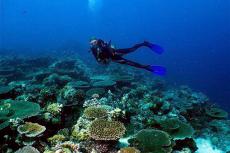Zanzibar: Diving Unguja & Pemba Island
The spacious, purpose-built dhow slid through the calm Indian Ocean. We were briefed sitting under the shade area of the deck, then kitted up and went through our buddy checks before a giant stride took us into the 30°C sea. Looking down, I could just make out the dive site, an old British lighter, 27 metres below me. It was 9:30 a.m. and the day was going fantastically.
Tags & Taxonomy
I’d started the morning in Dar-es-Salaam and caught a Coastal Airways Cessna 182 for the 20-minute 07:30 flight to Stone Town on the west coast of Unguja, more commonly known as Zanzibar, for some low-level sunrise shots of the outlying reefs. Ten minutes in a taxi, and I was sitting up at One Ocean Divers, a mug of coffee steaming next to me.
One Ocean started 16 years ago, and in 1999, it was taken over by Aussie Gary Greig and his South African wife, Gail. From one dive shop in Stone Town, they now operate from four other resorts around the island. Kit was dished out whilst more coffee was brewed and then consumed, before we were walked past the palm trees, down the small beach, and onto the waiting dhow. On the leisurely cruise out to a reef near Bawe Island, acquaintances were made and the loudmouth been-there-done-it-all-in-25-dives Harvard post-grad Italian diver was quickly identified and avoided as a buddy.
The wreck itself was a tad disappointing. Although the briefing by Amani had covered all the essentials and had been thorough in terms of safety procedures, no indication of the size of the wreck had been given. Hence, my initial thoughts of “With a lifeboat that size, it must be a huge wreck” soon turned to disappointment when Amani went straight for it. It was host to a large school of striped eel catfish and long strands of whip coral (that numbered one less after some unusual buoyancy “skills” from the Adriatic).
Following the dive plan, we then finned away following the contours of the sandy bottom up to some outcrops of reef, home to a bearded scorpionfish, and an assortment of triggerfish, butterflyfish, and coachmen.
By the time we’d started puttering along to The Aquarium at Murogo Reef (how many Aquariums are there around the world?), our bellies were grumbling, and the crew laid out a spread fit for Omani Sultans—once rulers of Zanzibar and the most successful slave and spice traders in Africa.
After samoosas, spring rolls, chapattis and fresh fruits and a leisurely spot of digestion during which we tried our best to convince our Italian expert that a Stonefish sting really would spoil his day, it was time to pull on our shorties again.
The visibility was around 15 metres, and the site deserved its moniker. Table and plate corals adorned the reef, and we spotted common lionfish, lots of nudis, an undulated moray eel, a hermit crab, huge gorgonian fans, a giant clam, and two blue spotted rays. However, the highlight of the dive was the large remora that took a fancy to Captain Fantastic’s bare leg, his squeals being vaguely reminiscent of dolphin chatter as he trashed around trying to avoid its attempted love bites. Back on the dhow, he was informed that remora like to live on sharks, and that one is never very far from the other. “I could’ve been killed then”, he shrieked. “If only,” thought I.
The reefs around Stone Town are fairly plentiful and other, larger wrecks exist, too. And whilst any aficionado of Bass Lake would gawk in amazement at the coral formations and the fish life, the reefs have suffered greatly from plagues of crown of thorns, draining the coral of any colour.
Stone Town
Back on shore in Stone Town, there is a bit of sightseeing to do. Central Stone Town is a labyrinth of narrow streets and alleyways, flanked by crumbling mansions and mosques. The main attractions are the massive Zanzibari wooden doors, Mercury’s restaurant and bar (Freddy of Queen fame is Unguja’s most famous son) by Big Tree, the House of Wonders, the Omani Fort, Tippu Tip’s house, the Hamamni Persian Baths, and the fish market (conservationists beware: you will find sharks here). The night food market in Forodhani Gardens is alleged, by the same guidebook that I used in Dar es Salaam, to host the best food market in East Africa. If the guidebook was written for flies, this is undoubtedly true.
Matemwe & Mnemba
Situated close to Mnemba Atoll, a shallow expanse of coral reef with a tiny heart-shaped island on its western fringe surrounded by some step drop-offs, Matemwe is the “must-dive” of Unguja. With average viz 20 metres or better, there are a multitude of sites to dive, and its calm conditions make it suitable for novices and experienced divers alike.
One Ocean’s centre here was on the premises of the Beach Village where standard rooms are comfortable and clean (...)
Download the full article ⬇︎

Originally published
X-Ray Mag #31
East Africa: Botswana, Tanzania and Mozambique; Salmon Swim in Paris again; Marine Protected Areas in the Pacific, Scandinavia, Brazil and elsewhere; Record Diver Pascal Bernabés anatomy of a deep exploration; Scapa Flow by Lawson Wood; Sharks are also teenagers; Skokumchuuk rapids; Seeing wrecks with sound; Photographing caves; Japanese Brazilian artist Marcelo Tatsuyoshi Kato; Plus news and discoveries, equipment news, books and media, wrecks, whales, sharks, sea turtles and more...











































